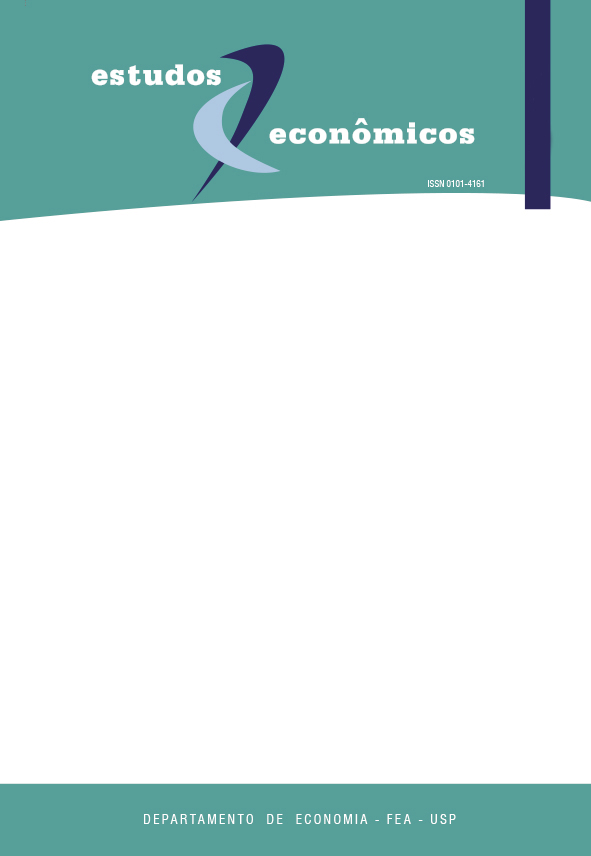Consumption habits and interest rate rigidity
DOI:
https://doi.org/10.1590/S0101-41612011000300002Palavras-chave:
rigidez da taxa de juros, demanda quebrada por empréstimos, hábitos no consumoResumo
Neste artigo proporcionamos um modelo microeconômico de empréstimos, em que o cedente do empréstimo é um banco monopolista e o tomador do empréstimo é um consumidor competitivo com hábitos no consumo que pode não honrar os seus compromissos de crédito em parte ou totalmente. Neste cenário, provamos que a curva de demanda por empréstimos é quebrada e, portanto, é possível encontrar rigidez da taxa de juros em equilíbrio, assim como resposta assimétrica da demanda por empréstimos a variações da taxa de juros. Finalmente, mostramos através de um exemplo que a oferta de crédito, como função do custo marginal do banco, exibe uma descontinuidade nesse custo marginal. Como consequência, diminuições na taxa básica da economia podem produzir um súbito aumento na demanda/oferta de crédito e na inadimplência.
Downloads
Referências
Calvo, G. (1983), Staggered Prices in a Utility-Maximization Framework. Journal of Monetary Economics, v. 12, n. 3, p. 383-398.
Campbell, J., Lo, A., Mackinlay, A. (1997), The Econometrics of Financial Markets. Princeton University Press, Princeton.
Carlton, D. W. (1986), The Rigidity of Prices. The American Economic Review, v. 76, n. 4, p. 637-658.
Carlton, D. W. (1989), The Theory and The Fact of How Markets Clear: Is Industrial Organization Valuable for Understanding Macroeconomics? Handbook of Industrial Organization (R. Schmalensee and R. D. Willig Eds.), v. 1, p. 909-946.
Carroll, C. D., Overland, J., Weil, D. N. (2000), Saving and Growth with habit Formation. The American Economic Review, v. 90, p. 341-355.
Dubey, P., Geanakoplos, J., Shubik, M. (2005), Default and punishment in general equilibrium. Econometrica, v. 73, n. 1, p. 1-37.
Dynan, K. (2000), Habit formation in consumer preferences: Evidence from panel data. The American Economic Review, v. 90, n. 3, p. 391-406.
Fuhrer, J. (2000), Habit formation in consumption and its implications for monetary-policy models. The American Economic Review, v. 90, n. 3, p. 367-390.
Hall, R. L., Hitch, C. J. (1939), Price Theory and Business Behavior. Oxford Economic Papers, v. 2, p. 12-45.
Hannan, T., Berger, A. (1991), The rigidity of prices, evidence from the banking industry. The American Economic Review, v. 81, n. 4, p. 938-945.
Keen, B. (2007), Sticky price and sticky information price-setting models: what is the difference? Economic Inquire, v. 45, n. 4, p. 770-786.
Mankiw, N. G., Reis, R. (2002), Sticky information versus sticky prices: A proposal to replace the New Keynesian Philip curve, The Quarterly Journal of Economics, v. 107, p. 1295-1328.
Means, G. (1935), Industrial Prices and Their Relative Inflexibility. Senate Document 13, 74th Congress, 1st Session (Washington D.C.).
Mills, F. C. (1927), The Behavior of Prices. NBER New York.
Neumark, D., Sharpe, S. (1992), Market Structure and the Nature of Price Rigidity: Evidence from the Market for Consumer Deposits. The Quarterly Journal of Economics, v. 107, n. 2, p. 675-680.
Rotemberg, J., Woodford, M. (1997), An Optimization-Based Econometric Framework for the Evaluation of Monetary Policy. NBER Macroeconomics Annual, 297-345.
Rotemberg, J., Woodford, M. (1998), Interest-rate rules in an estimated sticky price model, NBER Working Paper 6618.
Sherer, F. M. (1980), Industrial Market Structure and Economic Performance, 2nd Edition, Chicago: Rand McNally.
Scholnick, B. (1996), Retail interest rate rigidity after financial liberalization, The Canadian Journal of Economics, v. 29, n. 2, p. S433-S437.
Sweezy, P. M. (1939), Demand under conditions of oligopoly, Journal of Political Economy, v. 47, n. 4, p. 568-573.
Tirole, J. (1988), The Theory of Industrial Organization, Cambridge, MA and London: MIT Press.
Downloads
Publicado
Edição
Seção
Licença
Copyright (c) 2011 Wilfredo L. Maldonado, Augusto M. de C. Oliveira

Este trabalho está licenciado sob uma licença Creative Commons Attribution-NonCommercial 4.0 International License.
A submissão de artigo autoriza sua publicação e implica o compromisso de que o mesmo material não esteja sendo submetido a outro periódico.
A revista não paga direitos autorais aos autores dos artigos publicados.





 Atualizado em 14/08/2025
Atualizado em 14/08/2025